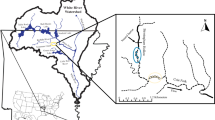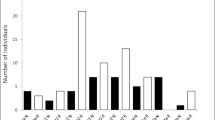Synopsis
Fish populations may be affected by predation and competition from various types of organisms, among which crayfish have been suggested as important actors. We here present results from stream surveys, suggesting that neither native noble, Astacus astacus, nor introduced signal crayfish, Pacifastacus leniusculus, necessarily affect fish population densities in temperate stream communities. Comparisons of fish densities within stream sites between years with absence and presence of crayfish showed no effect of either crayfish species. A further analysis of changes in fish densities between periods without and with crayfish in low, intermediate and high densities revealed that crayfish density did neither have an effect on fish densities. Our study is one of exceptionally few that consider the above aspects in long-term perspectives in natural systems, and we discuss that previously reported divergent results of crayfish effects on fish may be highly dependent on specific species and methods used, and that the effects of crayfish on fish populations deserve further attention to enable reliable predictions of community processes in streams.
Similar content being viewed by others
References
Anonymous. 1999. Restoration plan for the conservation of the noble crayfish. Swedish environmental protection agency (in Swedish)
Begon M., Harper J.L. and Townsend C.R. (1990). Ecology: Individuals, Populations and Communities. Blackwell Scientific Publications, Oxford
Carpenter J. (2005). Competition for food between an introduced crayfish and two fishes endemic to the Colorado River basin. Environmental Biology of Fishes 72: 335–342
Charlebois B.S. and Lamberti G.A. (1996). Invading crayfish in a Michigan stream: direct and indirect effects on periphyton and macroinvertebrates. Journal of the North American Benthological Society 15: 551–563
Cowx I.G. and Lamarque P. (1990). Fishing with Electricity: Applications in Freshwater Fisheries Management. Fishing News Books, Oxford., 248
Dahl J. (1998). Effects of benthivorous and drift-feeding fish on a benthic stream assemblage. Oecologia 116: 426–432
Degerman E. and Sers B. (1999). Electric fishing in theory and practice (In Swedish). Fiskeriverket Information 3: 69
Diamond J. (1986). Laboratory experiments, field experiments and natural experiments. In: Diamond, J. and Case, T.J. (eds) Community Ecology, pp 3–22. Harper and Row, New York
Dorn N.J. and Mittelbach G.G. (1999). More than predator and prey: a review of interactions between fish and crayfish. Vie et Milieu 49: 229–237
Dorn N.J. and Wojdak J.M. (2004). The role of omnivorous crayfish in littoral communities. Oecologia 140: 150–159
Edwards M.R., Combs D.L., Cook S.B. and Allen M. (2003). Comparison of single-pass electrofishing to depletion sampling for surveying fish assemblages in small warmwater streams. Journal of Freshwater Ecology 18: 625–634
Eklöv A.G., Greenberg L.A., Brönmark C., Larsson P. and Berglund O. (1998). Response of stream fish to improved water quality: a comparison between the 1960s and 1990s. Freshwater Biology 40: 771–782
Eklöv A.G., Greenberg L.A., Brönmark C., Larsson P. and Berglund O. (1999). Influence of water quality, habitat and species richness on brown trout populations. Journal of Fish Biology 54: 33–43
Englund G. (1999). Effects of fish on the local abundance of crayfish in stream pools. Oikos 87: 48–56
Foster J. and Slater F.M. (1995). A global review of crayfish predation with observations on the possible loss of Austropotamobius pallipes in the Welsh dye due to crayfish plague. Freshwater Crayfish 8: 589–613
Guan R.-Z. and Wiles P.R. (1997). Ecological impact of introduced crayfish on benthic fishes in a British lowland river. Conservation Biology 11: 641–647
Hart P.J.B. and Reynolds J.D. (2002). Handbook of Fish Biology and Fisheries. Blackwell Publishing, Oxford
Higgins P.J. (1985). An interactive computer program for population estimation using the Zippin method. Aquaqulture and Fisheries Management 1: 287–297
Hogger J.B. (1988). Ecology, population biology and behaviour. In: Holdich, D.M. and Lowery, R.S. (eds) Freshwater Crayfish: Biology, Management and Exploitation, pp 114–144. Croom Helm Ltd, London
Holdich D.M. (1999). The negative effects of established crayfish introductions. In: Gherardi, F. and Holdich, D.M. (eds) Crayfish in Europe as Alien Species: How to Make the Best of a Bad Situation?, pp 31–47. A.A. Balkema, Rotterdam
Ilheu M. and Bernardo J.M. (1993). Experimental evaluation of food preference of red swamp crayfish, Procambrus clarkii: vegetal versus animal. Freshwater Crayfish 9: 359–364
Kerfoot W.C. and Sih A. (1987). Predation: Direct and Indirect Impacts on Aquatic Communities. University press of New England, London
Kruse C.G., Hubert W.A. and Rahel F.J. (1998). Single-pass electrofishing predicts trout abundance in mountain streams with sparse vegetation. North American Journal of Fisheries Management 18: 940–946
Lima S.L. and Dill L.M. (1990). Behavioral decisions made under the risk of predation: a review and prospectus. Canadian Journal of Zoology 68: 619–640
Lodge D.M. and Hill A.M. (1994). Factors governing species composition, population size and productivity of cool-water crayfishes. Nordic Journal of Freshwater Research 69: 111–136
Lodge D.M., Taylor A.C., Holdich D.M. and Skurdal J. (2000). Nonindigenous crayfishes threaten North America freshwater biodiversity. Fisheries 25: 7–20
Maitland P.S. (1995). The conservation of freshwater fish: past and present experience. Biological Conservation 72: 259–270
Maitland P.S. and Campbell R.N. (1992). Freshwater Fishes. Harper Collins Publishers, London
McNeely D.L., Futurell B.N. and Sih A. (1990). An experimental study of the effects of crayfish on the predator-prey interaction between bass and sculpin. Oecologia 85: 69–73
Miller J.E., Savino J.F. and Neely R.K. (1992). Competition for food between crayfish (Orconectes virilis) and the slimy sculpin (Cottus cognatus). Journal of Freshwater Ecology 7: 127–136
Momot W.T. (1995). Redefining the role of crayfish in aquatic ecosystems. Reviews in Fisheries Science 7: 127–136
Nakano S., Miyasaka H. and Kuhara N. (1999). Terrestrial-aquatic linkages. Riparian arthropod inputs alter trophic cascades in a stream food web. Ecology 80: 2435–2441
Nyström P. (1999). Ecological impact of introduced and native crayfish on freshwater communities: European perspectives. In: Gherardi, F. and Holdich, D.M. (eds) Crayfish in Europe as Alien species: how to Make the Best of a Bad Situation?, pp 63–85. A.A. Balkema, Rotterdam
Nyström P. (2002). Ecology. In: Holdich, (ed.), D.M. (eds) Biology of Freshwater Crayfish, pp 192–235. Blackwell Science, Oxford
Nyström P., Brönmark C. and Granéli W. (1996). Patterns in benthic food webs. A role for omnivorous crayfish?. Freshwater Biology 36: 631–646
Nyström P., Brönmark C. and Granéli W. (1999). Influence of an exotic and a native crayfish species on a littoral benthic community. Oikos 85: 545–553
O’Brien W.J., Browman H.I. and Evans B.I. (1990). Search strategies for foraging animals. American Scientist 78: 152–160
Ogilvie M. and Pearson B. (1994). Wildfowl. Hamlyn Limited, London
Olsson, K., P. Stenroth, P. Nyström, N. Holmqvist, A.R. McIntosh & M.J. Winterbourn. 2006. Does natural acidity mediate interactions between introduced brown trout, native fish, crayfish and other invertebrates in West Coast New Zealand streams? Biological Conservation
Rabeni C.F., Collier K.J., Parkin S.M. and Hicks B.J (1997). Evaluating techniques for sampling stream crayfish (Paranephrops planifrons). New Zealand Journal of Marine and Freshwater Research 31: 639–700
Rahel F.J. and Stein R.A. (1988). Complex predator-prey interactions and predator intimidation among crayfish, piscivorous fish and small benthic fish. Oecologia 75: 94–98
Ross S.T. (1991). Mechanisms structuring stream fish assemblages: are there lessons from introduced species?. Environmental Biology of Fishes 30: 359–368
Rubin J.-E. and Svensson M. (1993). Predation by the noble crayfish, Astacus astacus (L.), on emerging fry of sea trout, Salmo trutta (L.). Nordic Journal of Freshwater Research 68: 100–104
Savino S.F. and Miller J.E. (1991). Crayfish (Orconectes virilis) feeding on young lake trout (Salvelinus namaycush): effects of rock size. Journal of Freshwater Ecology 6: 161–169
Stelzer R.S. and Lamberti G.A. (1999). Independent and interactive effects of crayfish and darters on a benthic stream community. Journal of the North American Benthological Society 18: 524–532
Stenroth, P. 2005. The different roles of crayfish in benthic food webs. PhD thesis, Lund University, Lund. 114 pp
Stenroth P. and Nyström P. (2003). Exotic crayfish in a brown water stream: effects on juvenile trout, invertebrates and algae. Freshwater Biology 48: 466–475
Townsend C.R. (2003). Individual, population, community and ecosystem consequences of a fish invader in New Zealand streams. Conservation Biology 17: 38–47
Usio N. (2000). Effects of crayfish on leaf processing and invertebrate colonisation of leaves in a headwater stream: decoupling of a trophic cascade. Oecologia 124: 608–614
Usio N. and Townsend C.R. (2001). The significance of the crayfish Paranephrops zealandicus as shredders in a New Zealand headwater stream. Journal of Crustacean Biology 21: 354–359
Vaughn C.C., Gelwick F.P. and Matthews W.J. (1993). Effects of algivorous minnows on production of grazing stream invertebrates. Oikos 66: 119–128
Vogt G. (1999). Diseases of European freshwater crayfish, with particular emphasis on interspecific transmission of pathogens. In: Gherardi, F. and Holdich, D.M. (eds) Crayfish in Europe as Alien Species: How to Make the Best of a Bad Situation?, pp 87–103. A.A. Balkema, Rotterdam
Xinya S. (1995). Effects of crayfish (Procambrus clarkii) on the survival of the fry and fingerlings of fishes cultivated in China. Freshwater Crayfish 8: 528–532
Author information
Authors and Affiliations
Corresponding author
Rights and permissions
About this article
Cite this article
Degerman, E., Nilsson, P.A., Nyström, P. et al. Are fish populations in temperate streams affected by crayfish? – A field survey and prospects. Environ Biol Fish 78, 231–239 (2007). https://doi.org/10.1007/s10641-006-0041-1
Received:
Accepted:
Published:
Issue Date:
DOI: https://doi.org/10.1007/s10641-006-0041-1




